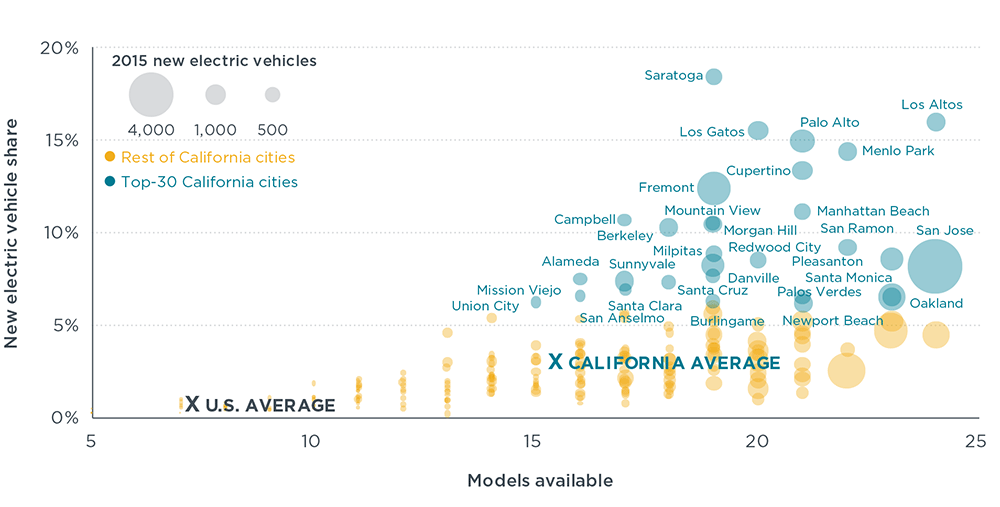Blog
The ascent of electric vehicles in California
We’ve seen some mixed signals in California on electric vehicles this summer. First, California lawmakers put the electric vehicle consumer rebates on hold. Then there were questions about whether the state’s Zero Emission Vehicle (ZEV) requirements need regulatory changes to energize sales and achieve the original goals. In response, a legislator sought to strengthen the 2025 electric vehicle requirements, only to later withdraw the bill. Finally, in late August, a breakthrough led to a broader climate bill heading for Governor Brown’s desk that could lead to tougher 2030 vehicle requirements. And then, after all that, the electric vehicle incentives were reinstated.
Questions about the progress and future prospects for electric vehicle deployment prompted this summer of political wrangling. We can inform these debates by taking a closer look at how the electric vehicle market is taking shape in California today. We’ve seen that, overall, cumulative California electric vehicle sales have surpassed 200,000. An impressive number, even by global standards—but we wanted to get deeper. To that end, we just completed an analysis of electric vehicle uptake across California cities to try to better understand the how, why, and where of the development of the early electric vehicle markets in California.
What did we find out? The quick answer is that we’re seeing a lot of progress, generally, and there are dozens of California hot spots with especially high electric vehicle uptake. California, with just 12% of the U.S. auto market has made up 54% of the electric vehicle market. The California electric vehicle uptake, with 3% of new vehicles being ZEVs, is 4 times the uptake of the U.S. average. California’s ZEV sales are at least several years in front of the ZEV requirements, which aim to make at least 15% of new light-duty vehicles ZEVs by model year 2025.
Much more interesting, though, is the rise of electric vehicles in the leading markets: There are 30 California cities where electric vehicles make up 6% to 18% of new car sales (See figure). My colleagues and I were all quite surprised to see the penetration so high, indicating the diffusion of the technology is moving beyond the “innovators” into the “early adopters” in some cities. This level of electric vehicle uptake amounts to 8 to 25 times that of the U.S. average in 2015. These leading cities tended to have about 20 electric vehicle models locally available, which is far more than the norm for U.S. cities.

California city electric vehicle share of new vehicle sales share and models available (vehicle registration data provided by IHS Automotive)
We assessed California’s electric vehicle promotion activities, analyzing many of potential underlying factors for links with California electric vehicle uptake. Public charging infrastructure is one of the larger factors influencing uptake on the local level. The leading cities also tend to have much higher workplace charging, especially in the San Jose area. Having high electric vehicle model availability is a prerequisite for market growth (relatedly, colleagues at the UCS just released a great in-depth analysis of that), and the ZEV regulation is a critical driver for this. In addition, the leading-edge cities in California also tend to implement wide-ranging local promotion activities (e.g., outreach events, informational websites, electric car sharing services, utility support, parking and permitting policies, fleet programs). These activities, while difficult to quantify, contribute to “network effects” (as other colleagues have indicated), where more infrastructure and electric vehicle owners in a given network further increase the value and attractiveness of electric vehicles.
What does all this mean going forward? Well, it certainly indicates that there are plenty of reasons that automakers and the market can stay out in front of the ZEV requirements. It also suggests what key actions are needed – sustained incentives, more charging infrastructure (e.g., utility plans), and expanded local support policies – for the continued growth of electric vehicles more broadly than these California cities.
So the Sacramento policy world provided a little bit of a roller coaster for electric vehicles in California this summer. But our analysis of the data shows that the diffusion of electric vehicles in the market could ultimately be the much more intriguing story. We’ll wait and see how it all unfolds.
